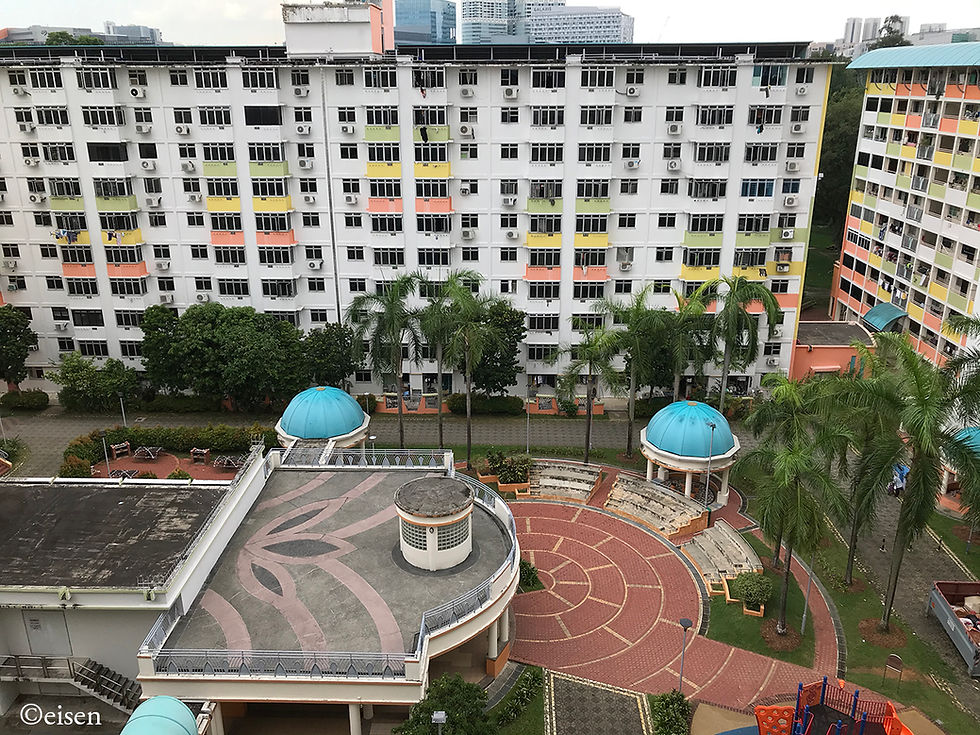Walks through Tanglin Halt
- Eisen
- May 2, 2021
- 4 min read
In a previous post, I shared about the disappearing loop of Tanglin Halt Road and Tanglin Halt Close, and its relation to Tanglin Halt Industrial Estate, which provided employment for the HDB estate of Tanglin Halt, one of Singapore’s oldest public housing estates.
For this post, I will share photos of Tanglin Halt Estate itself, which we explored over two weekends.
Tanglin Halt Estate’s fate was sealed in June 2014, when 31 blocks were placed under the Selective En bloc Redevelopment Scheme (Sers), the largest Sers project to date: Blocks 24 to 32, 33 to 38, 40 to 45, 55, 56, 58 to 60, and 62 to 66.
Here’s a bird’s eye view of Tanglin Halt Estate.

The estate has three neighbourhoods. There’s Tanglin Grove to the east; its blocks came up between 1969 and 1973, the exception being Block 24, completed 1983. Tanglin Halt Green is in the central portion; its blocks were built between 1971 and 1973. To the west is Commonwealth Green; most of its blocks came up between 1969 and 1973, with Blocks 60 and 62 appearing in 1983.
The 31 blocks and surrounding amenities to be demolished are shaded yellow. (Shaded red are Blocks 74 to 80 Commonwealth Drive, which were actually torn down a few years ago.)

Another view of the estate, to show the sheer scale of the Sers project.

By the 3rd quarter of this year, the last of 3,480 households would have gotten the keys to their new flats at SkyResidence@Dawson, at nearby Margaret Drive. I predict firm deadlines for everyone to move out of the estate by the 4th quarter, and demolition to begin next year, although the timeline may shift because of the ongoing COVID-19 situation.
For now, Tanglin Halt Estate is still very much alive and lived-in, although many units are already vacant and locked, their occupants moved to replacement flats elsewhere. The estate is gradually bleeding out from within, but those who are still around are quietly clinging on to whatever’s left. I would too, if I had been a resident from the estate’s birth in the 1960s.
1. Tanglin Halt Market, Tanglin Halt Food Centre, and surrounding shops (Blocks 46-1, 46-2, 46-3, 47, 48, 49)
These areas will be progressively cleared together with the flats, affecting 157 market and hawker stalls, 50 shops, and four eating houses.
Tanglin Halt Market, with its iconic curved roof. To the left is a very long queue for Taiwanese-style chee cheong fun (rice rolls).

Kian Seng San Kee, an old-school provision shop at Block 49. Established in 1968, it still sells (for now) all the snacks and sweets one would ever need for one’s childhood to be complete.


Evergreen (Hup Kee) Photo Studio at Block 49.

Peking Room Coffeeshop at Block 49. Despite its name, there’s a stall selling roti prata.

Two aunties resting in front of Block 46-3.

Block 46-2 used to house the Alexandra Neighbourhood Police Post and the Queenstown branch of the People’s Action Party Community Foundation headquarters, but they have both moved out.

Tanglin Halt Food Centre. Its footprint comprises three hexagons joined together.

2. Commonwealth Green
The flats in this neighbourhood have bright, cheery, orange walls.

Block 55, from the Rail Corridor. Of Tanglin Halt Estate’s three neighbourhoods, Commonwealth Green lies closest to the former railway tracks which once connected Singapore to Malaysia.

Block 55.

A view of the Rail Corridor, and Blocks 57 and 61, from the top floor of Block 60. The first two blocks do not fall under Sers; hopefully, the three-storey Singapore Improvement Trust (SIT) buildings will be conserved.

Many flats we passed by already have Notices of Possession pasted on their doors - a sign of finality and closure. This was on the 7th floor of Block 60.

Block 64.

The community square, from the top floor of Block 64.

Old-school grilles - a memory from my childhood.

3. Tanglin Halt Green
The walkway of Block 37. This neighbourhood has a pinkish colour scheme.

The top lift landing of Block 42... conveniently used for storage.

The back of Block 41, from the common corridor of Block 42. The common corridors of many older flats tend to face outward.

Block 38, from Block 40. It was raining heavily then.

The community square, from the top floor of Block 38. I hope such openness and greenery will be retained for future developments replacing Tanglin Halt Estate.

Essential services by the staircase...

Lay religion for one’s home.

4. Tanglin Grove
The open area between two blocks, which was a walkway with trees, grass, and space for bicycles, communal gatherings and first-floor occupants to hang their laundry. For these old blocks, the first floor also comprised flats, not void decks.

The blocks in this neighbourhood have a yellowish colour scheme.

Block 27, from Block 26.

Block 32, 7th floor.

Block 32, 9th floor.

The future and the past, next to each other: Block 32 in the foreground, at just nine storeys. It was completed in 1970. Towering over it in the background is Block 90 Tanglin Halt Road, part of the neighbourhood known as Commonwealth View. It soars to 40 storeys, and was completed in 2008, 38 years after Block 32.


Comments